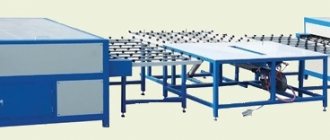The working process of an asphalt concrete plant:
The asphalt manufacturing process consists of several stages that are of fundamental importance in obtaining the finished product:
- Sifting of all components: crushed stone, gravel, sand, special additives is necessary to obtain the components of the desired fraction, free of foreign inclusions. Screening is carried out on equipment with vibrating screens and receiving bins;
- Crushing - required only for raw materials of a larger fraction than required according to the technological map;
- Heating of components - they are loaded into drying drums for uniform heating to the desired temperature;
- The heated material enters the mixer, where it is mixed with bitumen . After completing the mixing cycle, the output is a finished asphalt mixture.
Cooking technology
Let's consider more traditional technologies for producing asphalt concrete mortar, adopted by Gosstandart.
Return to contents
Preparation of raw materials
Change in structure when adding mineral filler.
The components of this material are:
- Sand acts as a fine aggregate that provides load distribution from the road surface to the soil. If you do not mix sand, the binder will spread and crushed stone will be forced to the surface.
- Mineral filler. Underneath this component can be rocks ground to a powder consistency: lime, chalk or sandstone. Their function is to fill the remaining free space. The most resistant of them is sandstone - it can withstand any chemical reactions, which is why it is often used near industrial chemical plants.
- Rubber is crushed to the state of millimeter crumbs, and this is the only way it is added to the composition. Its task is to make the finished composite flexible and resistant to moisture. Rubber-based asphalt concrete decks are much less susceptible to cracking and therefore do not require frequent repair work. However, such road surfaces cost a huge amount of money; therefore, they are used exclusively for particularly important road sections with increased loads, as well as those laid in difficult areas with an aggressive environment.
Preparatory work includes drying and sifting. Aggregates, as a rule, come to production in wet form. The retention of this moisture can compromise the strength properties of the asphalt deck. Therefore, by heating to 200 degrees, mineral raw materials are dried.
Before sifting, mineral aggregates are crushed and then sorted into fractions. If necessary, drying can be repeated after any stage of preparation. This depends on the type of technology used.
Return to contents
Mixing ingredients
Hot asphalt concrete.
According to the manufacturing method, asphalt concrete composites are divided into three types:
- cold;
- warm;
- hot.
These varieties differ from each other in the temperature at which the ingredients being combined are brought together during cooking. The production of warm or hot asphalt concrete solution is carried out by mixing other ingredients of the same temperature to a strongly or moderately heated binder. For cold mixtures, only one component is heated.
Mixing of the constituent ingredients is carried out at a temperature of 160 degrees. Using a mechanical belt conveyor, sand and gravel are poured into a common receiver. The solution can be crushed with aggregates and bitumen together. Or you can first combine crushed stone with sand separately and bring it to homogeneity.
During the process, it is necessary to constantly monitor the temperature inside the bin with materials so that it is always the same. After the finished solution has reached the desired thickness, it is transferred inside a special container for storage. The finished mixture is stored at a temperature of 150-180 degrees.
This container is capable of retaining the heat of the composite for up to four days. During this time, the asphalt concrete must be delivered to the customer, since further the material will begin to lose its strength qualities. Additional impurities are added while mixing the main components. Rubber crumbs are mixed into the ready-to-use, heated mixture.
Return to contents
Basics of efficient asphalt production:
To organize the production of asphalt mixture, equipment is required that meets the following principles:
- Long service life guaranteed by the manufacturer;
- Minimum number of planned replacements of components and assemblies;
- Possibility of training customer personnel directly at the manufacturer;
- Using developments from well-known industry enterprises from around the world;
- Possibility of modification of equipment to solve specific customer problems;
- Flexible production and installation times.
A good manufacturer will not only offer equipment that meets the specified standards, but will also provide detailed advice on the entire asphalt production. His proposal should provide the opportunity to purchase asphalt plants with the required parameters.
For example, in terms of dimensions, production indicators, and working with a certain type of raw material. The customer only needs to provide information. Then the engineers themselves will prepare the necessary project from a standard version, or offer an individual one, created for this customer. Only this approach will allow us to obtain a profitable asphalt plant.
Asphalt concrete plants for asphalt production:
We, being the official dealer of PJSC Kredmash, offer reliable asphalt concrete plants. To get a consultation, call our toll-free number.
Types of asphalt concrete production plants
There are two types of asphalt concrete production plants: cyclic and continuous. They differ in mixing processes, dosage of components, amount of material produced, methods of storing it, as well as mobile capabilities.
Return to contents
Cyclic mechanism
The cyclic mechanism has additional technical equipment in the form of a tower and a screen, through which raw materials are sorted. Next, the material is divided into certain parts, each of which is individually sent to dry inside the drum. This production technique makes it easy to modify a given composite recipe.
The disadvantage of this production process is the stationary and immobile nature of the installation, as well as the small volumes of the output product. In addition, the screening process leads to some idle time in highly heated bins - either they are empty, or one of the ingredients is missing. Thus, the quality of the composite deteriorates. This may result in losses. Typically, this type of asphalt concrete mixture production is used in large cities.
Return to contents
Continuous Asphalt Concrete Composite Plant
The continuous asphalt composite plant is famous for its simplicity and does not require any towers. The device can be transported without problems and is easy to install. However, it also has its pitfalls. One of these stones is considered to be the absence of a rumble. After all, most of the crushed stone used needs fractionation, and without screening this is unrealistic. Due to this drawback, the recipe changes and the quality characteristics of the resulting product deteriorate.
Some manufacturers are addressing this shortcoming by adding a stand-alone sorter to the equipment, while maintaining a cost-effective manufacturing process. The main positive point here is that production is carried out continuously, without stopping, which ultimately gives much more products, and, accordingly, income.
Return to contents
Advantages and disadvantages of the material
It is worth noting the following:
- For light-duty applications, asphalts are not very expensive, unlike the multimillion-dollar cost of laying highways;
- With proper quality, asphalt is irreplaceable in any weather.
- Numerous defects that are clearly visible to pedestrians are rarely visible from a car window;
- The production of heated and viscous mixtures is not a simple task, despite the automation of the process;
- The difficulty of using heated mixtures is partly compensated by the appearance of cold asphalt;
- Asphalt paths in the garden are not made precisely because of the unpleasant smell of bitumen, although over time the mixture hardens and causes inconvenience only in hot weather.
Existing alternatives to asphalt are currently too expensive and not as practical. Unlike other building materials, asphalt is being improved not by developing new materials, but by upgrading old ones.
The widespread introduction of polymer modifiers makes it possible to fundamentally improve the properties of road surfaces and expand the limits of their technological application, which is confirmed by numerous tests of the material.
Laying
Immediately after the material is delivered, asphalting occurs. If everything is done correctly, there will be a reliable coating for a long time, there will be no cracks.
There is also a special procedure for paving:
- 1) First, the asphalt is calculated (the area and cutting are measured);
- 2) Then the place for laying is prepared, the asphalt is dismantled and anchors are installed.
- 3) The area is cleared of moisture, dust and dirt (this is done thoroughly, otherwise it will affect the road, the coating will not stick and will begin to creep as a result);
- Primer . Bitumen and bitumen emulsion are suitable for it, they are also suitable for ordinary asphalt
- Laying . Large equipment is used if the area is more than 25 m^2. If it’s less, then workers lay out the asphalt manually, because using machinery is completely unprofitable.
- Seal . It begins immediately after the asphalt has been laid. To make the mixture dense, rollers or other static equipment are used. If the area is small, then use manual compaction.
In order for asphalt to have good quality, several factors and rules must be taken into account:
- stick only to proven and appropriate products; there must be a valid GOST (if the asphalt was delivered late and it is no longer what it should be, then it does not need to be laid);
- Thoroughly clean the surface on which the asphalt will be laid (without dirt, dust, moisture, or other chemicals, otherwise problems will begin later and the asphalt will crumble within a couple of months);
- it is also important to take into account the weather (if there is precipitation and it is cold, then work cannot be done, and in winter it is completely forbidden to lay asphalt).
By the way, read this article too: What does oil consist of?
Compliance with the rules, taking into account the type of asphalt, is very important, because some types require a different temperature or operating time. Asphalt is sprinkled with cement to strengthen the road life and make the asphalt more durable.
Kinds
There is a division of asphalt concrete material into three groups. The difference between these categories lies in the exact temperature at which a substance such as bitumen melted. The three main groups include hot, warm and cold asphalt. The difference also lies in the temperature at which work on laying a new road surface is carried out.
- The first type is hot laying of the material. This mixture contains bitumen, which melted at very high temperatures, and therefore, to lay it, it is necessary to heat the asphalt to 120 degrees Celsius and higher. Most often, the substance is used for the construction of new highways.
- The second type is warm styling. The solution contains low-viscosity bitumen, which should be heated to 40-80 degrees Celsius.
- The last type is cold asphalt, or cold paving. The mixture includes a special bitumen base, which can be used if the air temperature is not lower than 10 degrees Celsius. This option is implemented most often. The main area of application is repairing highways, filling holes or potholes in existing surfaces.
Application
Asphalt was originally used for roads such as:
- paving roads (only asphalt is suitable, since there is no similar material);
- production of pedestrian crossings, sidewalks, playgrounds;
- public places.
Fine-grained is replaced with concrete or slabs if we are talking about areas where there are always a lot of people.
It is also used for the production of building materials, for example, varnishes, glue, roofing felt, tiles. Their production uses the same technologies as for asphalt.
How to check the parameters of the road surface and raw materials for its production
To avoid purchasing low-quality asphalt concrete, you should ask the seller for a certificate of product conformity. It is issued only after passing a set of tests corresponding to GOST or SNiP (depending on the scope of application).
In the quality control market, there are a number of regional laboratories that conduct sampling and testing of asphalt pavements. During the study, an average sample is selected from the total mass of the material. Analysis of the road surface is carried out by examining a core, which is an asphalt core obtained by drilling the road with a special hollow drill.
Classification of asphalt mixture
An important component of the solution is crushed stone. Depending on its size, the asphalt mixture is divided into types:
How modern planes fly
- Dense. If the size of the crushed stone does not exceed 5 mm, then the paths for pedestrian movement are covered with the solution. This type of asphalt is called fine-grained. If the size of the stones reaches 10-15 mm, then the upper part of the roads is covered with a coarse-grained mixture.
- Porous. In the pie, highways occupy the lower part. The composition contains a lower percentage of bitumen than a dense coating.
- Highly porous. Roads for heavy-duty vehicles are being laid. The sizes of crushed stone granules reach 40 mm. This provides the coating with a high degree of hardness. There is no pressing of the upper layers of soil into the lower ones. During operation there are no risks of material subsidence and shifting.










